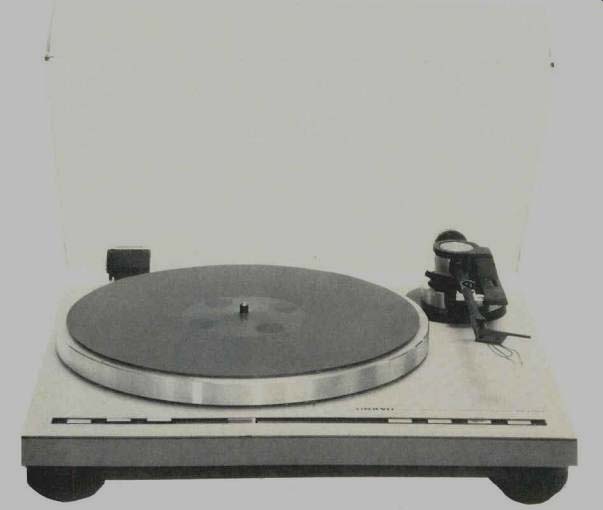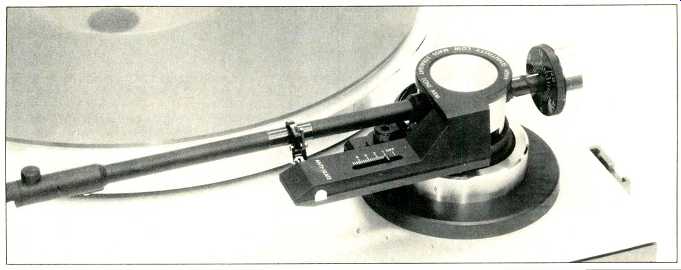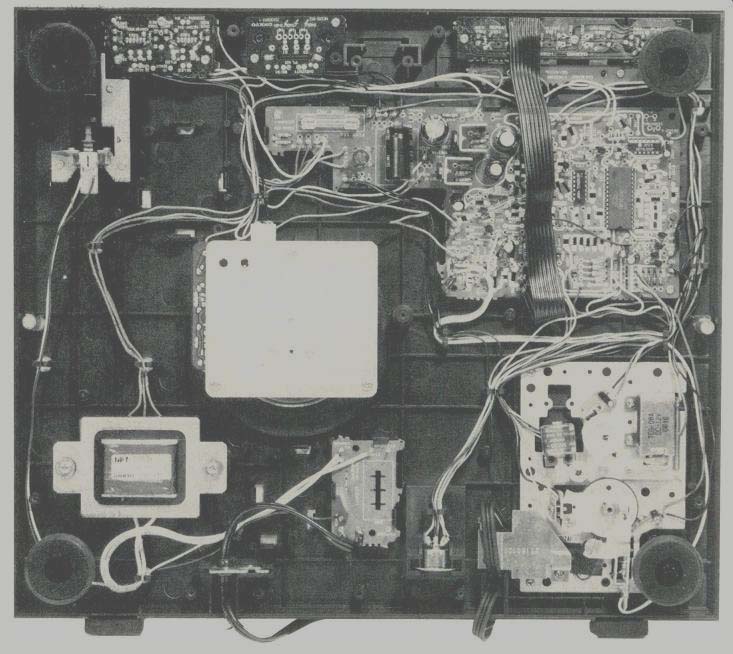
Manufacturer's Specifications
Drive Motor Type: Direct, quartz controlled; separate motor for tonearm.
Speeds: 33 1/3 and 45 rpm.
Wow and Flutter: Less than 0.025 percent, wtd. rms.
Rumble: Better than -75 dB, DIN 45 539 "B."
Cartridge Weight Range: 5 to 9 grams.
Dimensions: 16 1/3 in. (41 .9 cm) W x 15 in. (38.1 cm) D x 5 in. (12.7 cm) H.
Weight: 14.3 lbs. (6.5 kg).
Price: $329.95.


The Onkyo CP-1150F is a fully automatic turntable with some rather unusual features which make it a little different from the run-of-the-mill designs. For example, there is a Repeat function which allows a record to be played continuously from any selected point to disc end and, probably more useful, a button marked Search which activates a motor to drive the arm in either direction. At the desired point, the arm is then lowered by the cue button--the arm motion is so smooth that you can almost move it groove by groove. Another interesting idea is the provision of a jack for an optional remote unit which can control most functions. This remote unit is designated the RC-5T.
Perhaps the most striking feature is the platter mat. Instead of the black rubber material we are used to seeing, this one is made from a transparent plastic, but more about that later. The unit itself has the current low-profile styling with all the controls disposed on a narrow shelf-like projection at the front where they are accessible with the dust cover closed. There are three push buttons on the left; number one is the power on-off switch, the second selects the speed, while the third is the record size (7 or 12 inches) selector. A light behind a bezel near the center shows when the power is switched on, and way over on the right-hand side are four more push buttons, Repeat, Search, Cueing, and Play/Reject.
The arm is a statically balanced type, measuring 878 inches from pivot to stylus. It is made from tubular carbon fiber, as is the headshell. The words "High Sensitivity Low Mass Straight Tone Arm" are inscribed around the pivot trim, and the anti-skating slide dial projects forward on the right and also forms the arm rest. The tracking force scale on the counterweight is calibrated from 0 to 3 grams, while the anti-skating slide has markings up to 4.8 grams.
The motor is a direct-drive type with quartz-lock servo control, and it turns a 3-lb. platter which is an aluminum die casting. As with many present-day turntables, a high-impact plastic is used for the base. The four insulated feet use a combination of felt, coil springs, and rubber to give acoustic isolation--needed because the arm and motor are solidly mounted on the top board. The unit is finished in a metallic gray and silver and comes complete with an overhang gauge plus some hardware.
Measurements
For test purposes, an Osawa MP-30 MM cartridge was mounted on the low-mass headshell which, by the way, is fitted with a locking screw. This represents something of a "worst case" combination in that this arm and cartridge combination is about as far from optimum as it's possible to get. This is not the fault of either the arm or the cartridge, of course, but simply represents one of the few places left in hi-fi where two perfectly fine components can produce a less-than-optimum result. The Onkyo arm showed up rather well in this test, where the effect of the mismatch is seen in the resonance-a rise of 3.5 dB at 8 Hz. The optimum point for this resonance is generally thought to be in the 11 to 15 Hz range, below any recorded information and above the warp frequency range of 4 to 6 Hz.
As mentioned earlier, the platter mat is made of plastic, and it is described as a "transparent amorphous plastic." This mat fits on a "diamond-cut plane platter," so it lays perfectly flat with no air spaces in between. At one time, it was thought that the only function of a platter mat was to damp out some of the motor vibrations, but we now know that a mat must also absorb vibrations generated by the stylus in the record without introducing resonances. We know, too, that some mats with heavy ribs can cause problems because the air pockets act as miniature Helmholtz resonators, while mats with reflective surfaces can have a poor interface and increase the change of airborne acoustic feedback. So what it amounts to is this: The design of an ordinary platter mat is not at all simple. Some manufacturers rely on soft, absorbent materials, sometimes aided by a separate weight, while others prefer materials having a relatively high density. Onkyo's choice is an amorphous kind of polyethylene, plus an absolutely flat platter.
As far as rumble is concerned, the figures are comparable with other high-quality units, and changing over to a rubber mat made no significant difference. However, the Onkyo mat was clearly superior in recovery from shock excitation pulses which caused some subsonic ringing with the softer mat. To be honest, I don't know how important this is, but I suppose it could have an effect on some kinds of feedback. The four triple-insulated feet do a good job in isolating the unit from vibration, and acoustic feedback is unlikely to cause problems. Overall, the unit is clearly well thought-out in this regard.
Wow and flutter was 0.04 percent (DIN 45-507), and rumble measured a low-62.5 dB using the ARRL weighting. Both vertical and lateral arm bearing friction were insignificant. Calibration of the tracking force dial was about 5 percent high above one gram. The optimum tracking force for the MP-30 cartridge was found to be 1 .8 grams with the anti-skating set a trifle higher.
Speed was less than 0.2 percent fast on both ranges and was unaffected by a.c. line changes.
Using the gauge supplied by Onkyo, the offset angle was 21 degrees with an overhang of half an inch, giving maximum tracking error of +3 and-1 degrees. By increasing the overhang to % inch and angling the cartridge slightly in the mount, the error was modified to +2 and-1.25 degrees. For this exercise, a Cart-A-Lign protractor gauge was used. This ingenious gadget has the null points at 2.6 and 4.76 inches, and the built-in mirrors make it one of the most accurate of the inexpensive gauges now available.
Use Tests
The CP-1 150F proved to be very easy to use, although the Search control took a little getting used to. Depressing the but ton sends the arm over the record, where it stops as soon as the button is released. However, if you then decide the arm has not moved far enough, a second touch of the button moves the arm back in the other direction! In other words, sequential button pressing results in bidirectional arm movement. The cue control works very well indeed, lowering the cartridge slowly and gently.
As to the Repeat facility, well, it obviously has its uses but it would be even more useful if a single selection anywhere on the record could be repeated--not just the last band or bands. I do prefer having some method of repeat play, however, and this one worked well in my tests.
All in all, the Onkyo CP-1 150F is a nicely styled, well-engineered unit which is likely to make a special appeal to those who desire the convenience of a special cueing system like this one.
-George W. Tillett
(Audio magazine, Aug. 1981)
Also see:
Onkyo CP-1130F turntable (ad, Dec. 1981)
Onkyo turntables (ad, Mar. 1979)
Thorens TD160 Super turntable (Dec. 1981)
Optonica turntable (June 1977)
Kenwood KD-5070 turntable (Mar. 1979)
= = = =